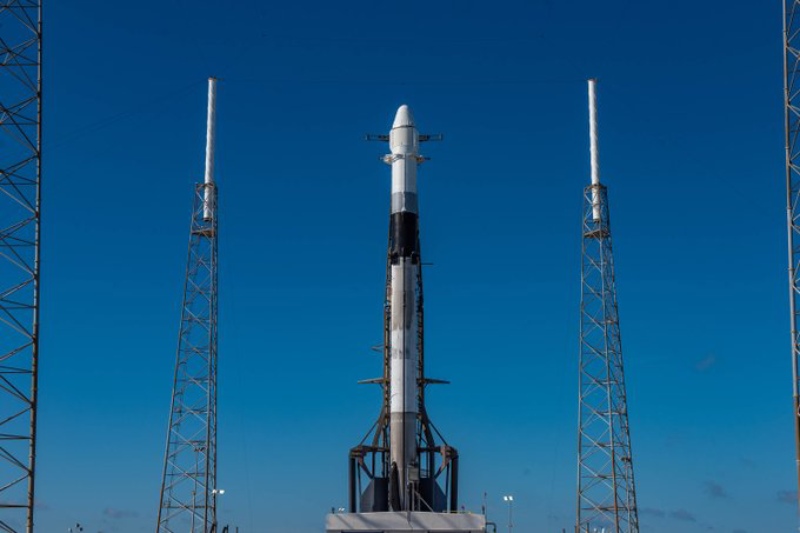Cargo Dragon Takes Off for Space Station Following Soyuz Scrub

On March 21, a cargo spacecraft made its way towards the International Space Station, following the unusual last-minute cancellation of a Russian Soyuz spacecraft’s launch to the station.
At 4:55 PM Eastern, a Falcon 9 blasted off from Space Launch Complex (SLC) 40 in Cape Canaveral. Twelve minutes after liftoff, the cargo Dragon spacecraft, which was the rocket’s payload, was released from the upper stage of the Falcon.
On March 23, at around 7:30 a.m. Eastern, the Dragon, carrying out the CRS-30 mission, is expected to dock with the International Space Station (ISS) and stay there for around one month. 2,841 kg of cargo, comprising a variety of science experiments, crew supplies, and station gear, are being carried by the spaceship.
This is the first time that Dragon has launched from SLC-40 using the current version. Using the launch tower and crew access arm at neighboring Launch Complex 39A, SpaceX has launched Crew Dragon spacecraft and its cargo counterpart there. CRS-20, the last launch of the original cargo version of Dragon, took place in March 2020 and was the last cargo mission from SLC-40.
Since then, SpaceX has constructed a tower at SLC-40, reopening the pad for crewed and eventually cargo operations. About 24 hours prior to launch, the crew access arm of cargo missions permits the loading of time-sensitive cargo later.
During a briefing on March 19, SpaceX’s director of Dragon mission management, Sarah Walker, stated that the new tower at SLC-40 is “nearly functionally identical” to LC-39A. The “slide wire” baskets at the older pad include an emergency escape system that is distinct from the improved elevator at the current pad, which is located at LC-39A. SLC-40, on the other hand, uses rapidly unfolding chutes that allow users to descend.
In order to relieve traffic at the pads during instances like the one in February when the launch of the IM-1 lunar lander mission from LC-39A delayed NASA’s Crew-8 commercial crew flight from the same pad by more than a week, SpaceX constructed the tower at SLC-40 to act as a backup to LC-39A. Additionally, it offers redundancy in case one pad is broken.
Walker stated that while SpaceX and NASA finalize the documentation to authorize use of the pad for NASA commercial crew flights, there are currently no concrete plans to launch a crewed mission from SLC-40. “They’re on schedule to be penciled in for NASA crewed missions prior to Crew-9, but we’ll switch to SLC-40 for the manifest when necessary.”
Soyuz Postponement
Originally, March 21st’s launch of CRS-30 was meant to be the second mission to the International Space Station. At 9:21 a.m. Eastern, Roscosmos planned to launch the Soyuz MS-25 mission on a Soyuz-2.1a rocket.
Nevertheless, the countdown to launch was stopped 20 seconds before takeoff. At first, NASA did not know what was causing the hold that prevented the launch.
Several hours later, Roscosmos blamed the incident on “a voltage drop in the chemical current source” in a statement posted in Russian on social media. However, the statement provided no further details. The next launch window, according to it, is on March 23 at 8:36 a.m. Eastern. Prior to the launch on March 21, the spacecraft was supposed to dock within three hours. However, NASA stated that a launch on March 23 would result in a docking two days later.
Later in the day, NASA released a statement stating that “low voltage reading in the Soyuz rocket electrical system” was the reason ground support equipment aborted the launch. This seems to be the first time a mission with a Soyuz crew has been canceled in the last stages of its countdown.
NASA astronaut Tracy C. Dyson, Roscosmos cosmonaut Oleg Novitskiy, and guest cosmonaut Marina Vasilevskaya from Belarus are all traveling to the station on Soyuz MS-25 for a six-month tenure. After docking on Soyuz MS-24 with NASA astronaut Loral O’Hara, who is wrapping up a six-month stint on the International Space Station, Novitskiy and Vasilevskaya will return in around ten days. Oleg Kononenko and Nikolai Chub, cosmonauts for Roscosmos, who launched to the International Space Station (ISS) with O’Hara on Soyuz MS-24 last September, will spend an extra six months there.